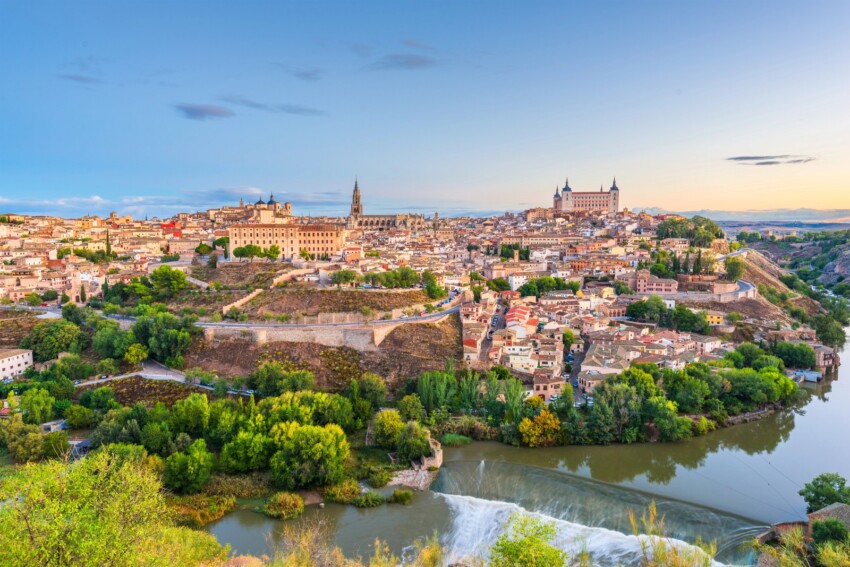

Let yourself be enraptured by the magic of Toledo, the city of three cultures, scenically perched on a gorge of the Tagus River.
Its characteristic feature is the abundance of splendid buildings for the worship of the three main religions, the result of the peaceful coexistence of the Christian, Arab and Jewish communities. Toledo’s origins, however, are much older and as you stroll through the city you will come across traces of its Roman and Visigoth past.
A name inextricably linked to Toledo is that of El Greco, one of the most important figures of the Spanish Renaissance. His works are scattered in several churches in the city and in a museum that reconstructs the social and cultural environment that influenced his work. It is not the painter’s house but a faithful reconstruction of what it might have looked like. Disappointed? With over 100 pictorial masterpieces to admire, you won’t regret the price of admission.
Easily accessible from Madrid by car or public transport, Toledo is the ideal destination for an unforgettable day trip from capital to former capital. Try to catch the last train of the evening so you can enjoy a beautiful sunset over the city.
The centre of Toledo is an open-air museum, with many historical and cultural attractions to visit. It is unusually rich in religious buildings of different cultures, a legacy of the peaceful coexistence of Arabs, Christians and Jews over many centuries. Here are the attractions not to be missed in Toledo.
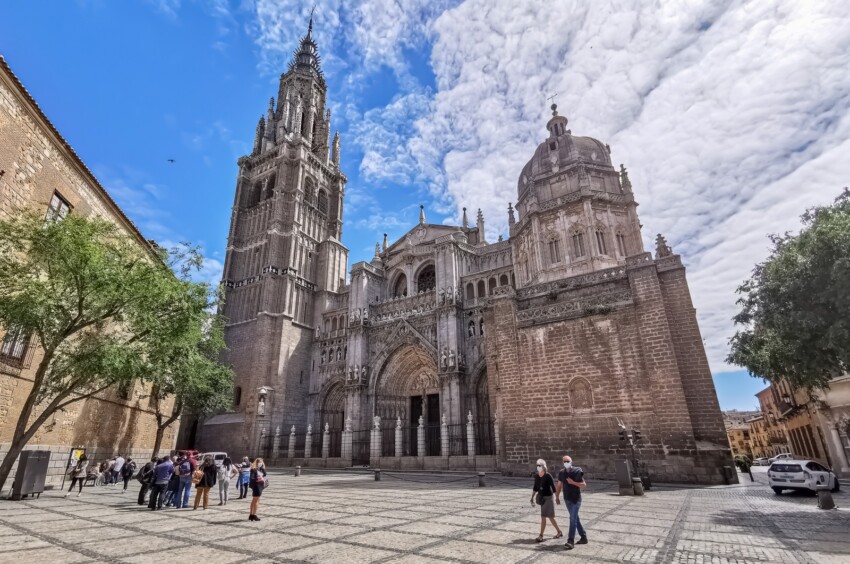
Toledo Cathedral alone is worth a trip: this monumental building, a masterpiece of Gothic art, is listed among the 10 most beautiful cathedrals in Spain and it is no exaggeration to call it one of the most beautiful in Europe. Its construction began in the 12th century, on the remains of an earlier mosque and a Visigoth cathedral, and was not completed until the 15th century, with an overlapping of styles that testifies to the passage of time.
The cathedral holds priceless art treasures, including paintings by El Greco, Velázquez and Goya. The most impressive piece, however, is the Custodia de Arfe, a magnificent example of silver and gold-plated jewellery made between 1517 and 1524, approximately 2.5 metres high and decorated with 260 images.
This impressive object weighing over 200 kg is carried around the streets of the city during the Corpus Christi procession.
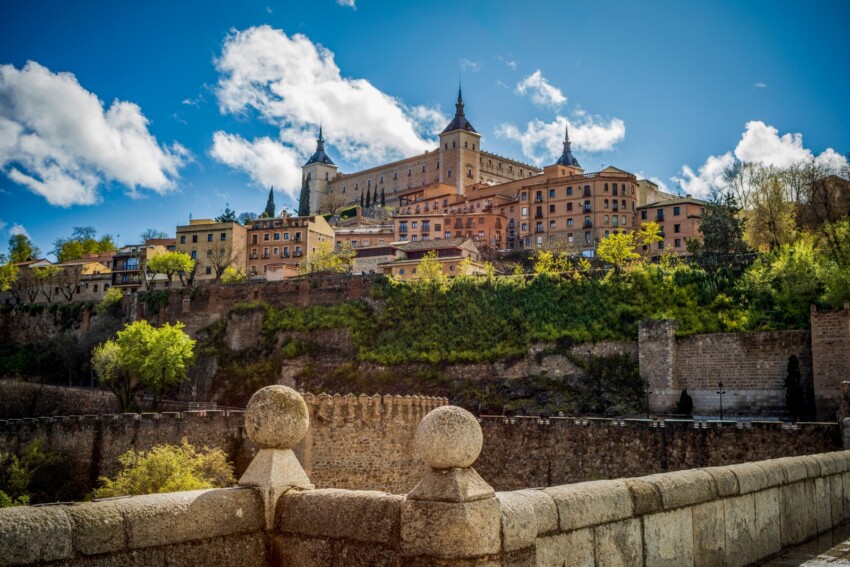
The impressive building that dominates the city of Toledo from above is the Alcázar, a fortress that is at times striking and at times disturbing.
Built in the 10th century by Abd ar-Rahman III, it was soon modified by the Christians, transformed into a royal residence for Charles I and finally used as a military academy. Seriously damaged during the Spanish Civil War, it was later rebuilt.
It is now home to a huge museum, with a military section and one dedicated to the history of Spain, and a public library. It is worth getting up here to admire the large central courtyard, the imperial staircase and the belvedere from which you can enjoy a splendid panoramic view of the Tajo river and the city surroundings.
The fortress of Toledo was the scene of an episode that has remained in the history of the bloody Spanish Civil War. The protagonist of a stoic defence of the Alcazar for 70 days was the Nationalist commander José Moscardó Ituarte, who refused to surrender to the Republican soldiers even under the threat of his son’s assassination.
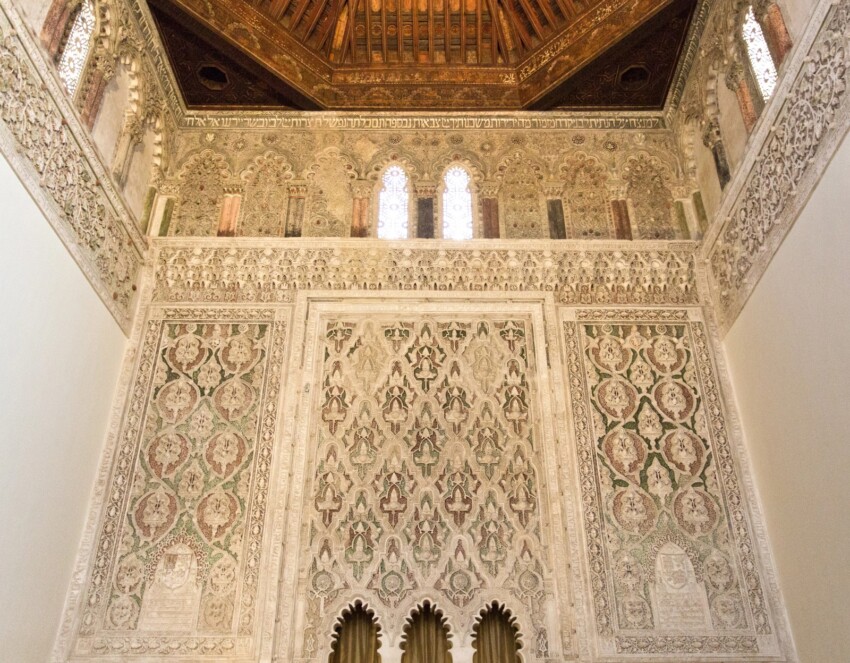
The Synagogue of the Transit, the most beautiful of the two Mudejar-style synagogues in Toledo, was built in 1355 by special concession of King Pedro I. Recently restored, it is now home to the Sephardic Museum, which tells the story of the Jews in Spain through historical testimonies, costumes, sacred objects and a memorial garden.
During a visit to the museum, admire the Mudejar-style coffered ceilings and walls richly decorated with Jewish inscriptions and a stylised wheat ear motif.
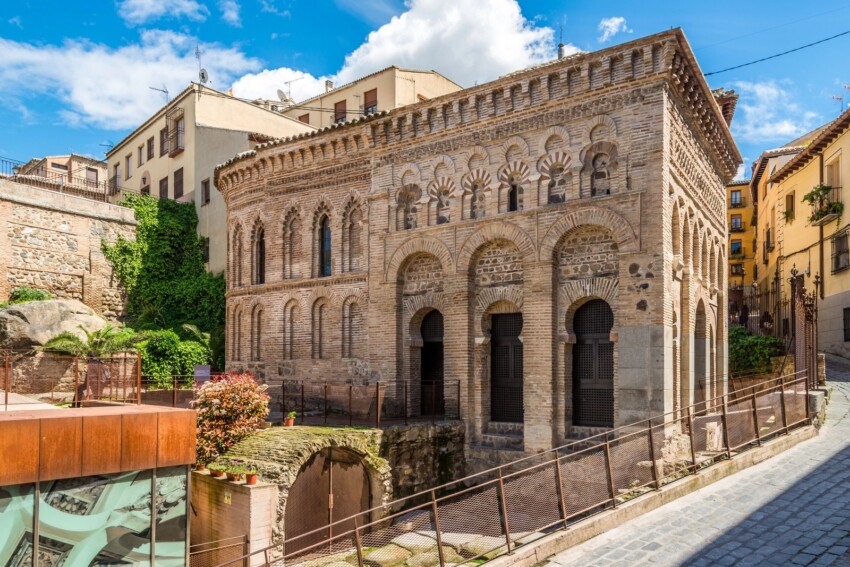
The small but very pretty Mosque of Christ of Light was built in the late 10th century on the model of the much more majestic mosque in Cordoba and later converted into a Catholic church. However, the original arches and vaulting remain.
Have you wondered why the curious name of the Mosque of the Christ of Light? According to legend, King Alphonse VI’s horse suddenly stopped in front of the mosque, refusing to continue. Upon investigating the incident, a statue of Christ dating back over 300 years was found, with an oil lamp still working.
The Church of San Tomé is world famous for housing one of El Greco’s masterpieces: ‘The Burial of the Count of Orgaz’. The painting, considered one of the artist’s most important works, is in its original location and is a perfect example of El Greco’s ability to fuse the earthly with the heavenly.
The building, originally a mosque turned into a church in the 12th century, retains a beautiful Mudejar bell tower. The visit is essential to understand El Greco’s art and his connection with Toledo.
Make a little effort and visit another beautiful religious building in Toledo. The Monastery of San Juan de los Reyes was provocatively built by the Catholic kings Isabel and Fernando in the Jewish quarter of the city in order to demonstrate the supremacy of their faith.
Seeing this imposing 15th century monastery, one cannot doubt the seriousness of their intentions. The richest element of this extraordinary construction is the splendid two-tiered cloister, one in flamboyant Gothic style and one in Mudejar style, richly decorated with statues, arches, vaults, pinnacles. In the centre of the cloister is a beautiful garden with orange trees and roses.
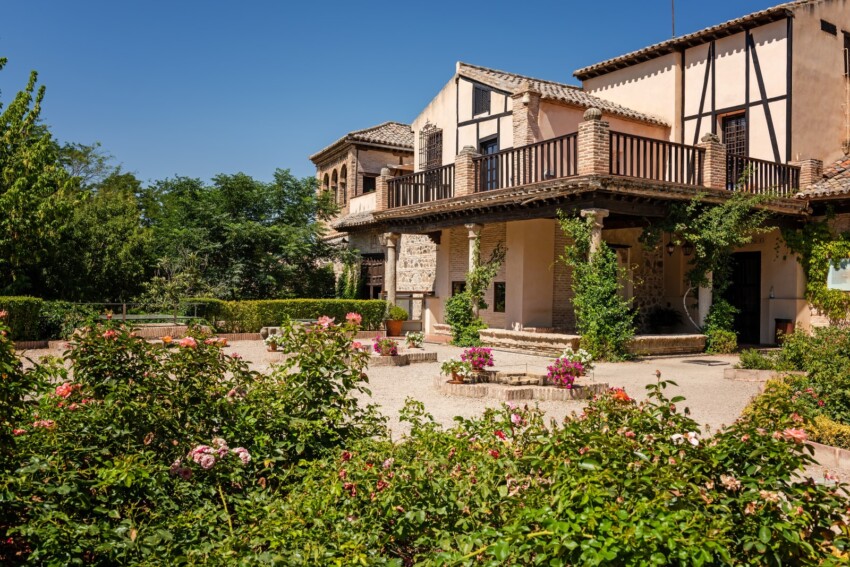
The El Greco Museum, located in the Jewish quarter, is housed in a 16th century house-palace that recreates the environment in which the artist lived. Although it is not El Greco’s real home, the museum offers an excellent introduction to the painter’s life and work through a significant collection of his paintings.
The mission of this very important cultural institution is not to show the real rooms in which the artist lived and worked, but rather to give an insight into the socio-cultural context of the time and the importance of El Greco’s work and personality in early 17th century Toledo.
In addition to El Greco’s works, the museum exhibits period furniture and objects that allow us to imagine daily life in 16th century Toledo. The garden, with its typical Mediterranean vegetation, offers a pleasant place to rest during the visit.
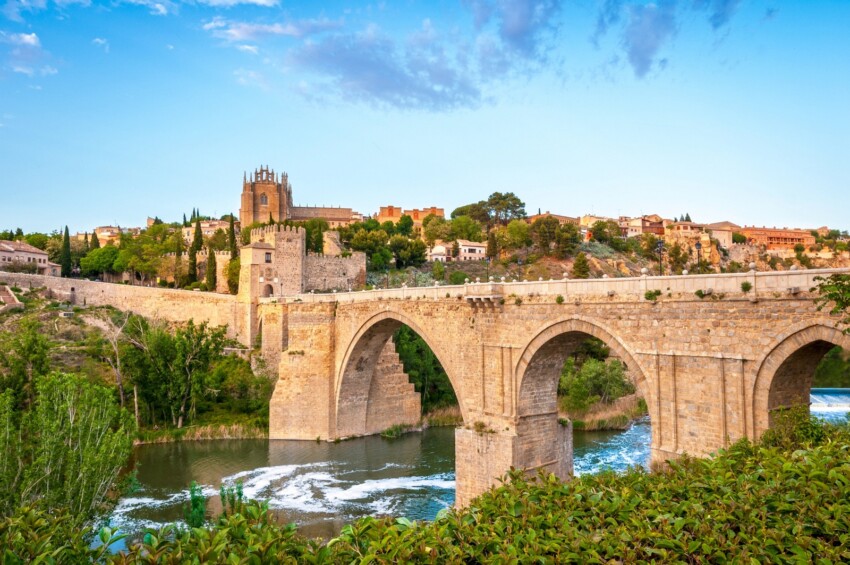
The Bridge of San Martín is one of the most photographed symbols of Toledo. This 14th century Gothic bridge, with its five arches spanning the Tajo, offers spectacular views of the old city and the river. The fortified tower that protects it and the medieval gateway that introduces it are perfectly preserved.
The bridge is also a privileged vantage point to admire the sunsets over Toledo, when the sunlight tinges the ancient stones with gold to create an unforgettable spectacle.
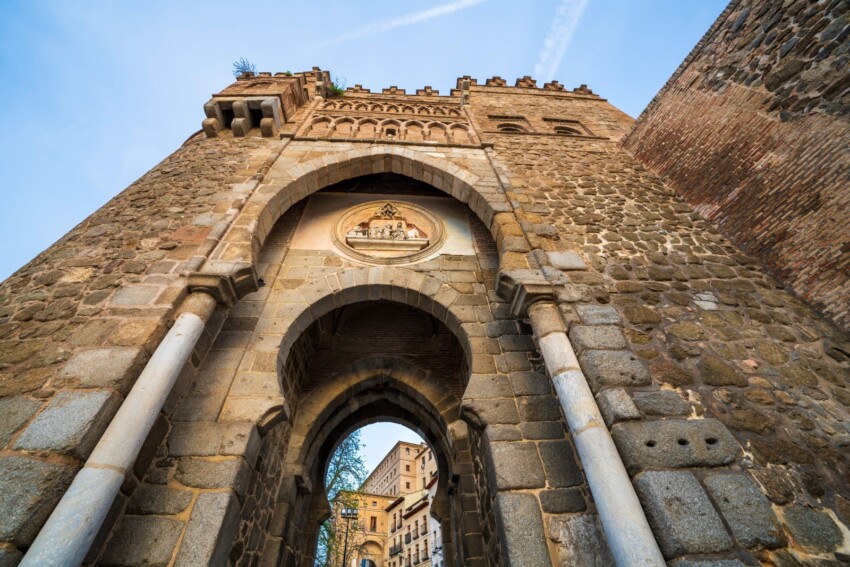
Along the fortified walls of Toledo there are numerous gates, some of them richly decorated. The main entrance to the city is Puerta de Bisagra9, of Muslim origin and modified during the reign of Charles I; set between two imposing bastions, it is surmounted by the imperial shield.
Older is Puerta de Alfonso VI10, known as the Old Gate of the Bisagra, which is a more faithful example of the Muslim original. Another gate you can admire is Puerta del Sol11, in Mudejar style, dating back to the 13th century.
Once the scene of bullfights and before that of executions by the Inquisition, the elegant Plaza de Zocodover12 is now the ideal place for a break: sip a coffee in one of the elegant cafés in the square and watch the people go by.
After resting, look for theArco de la Sangre13, a horseshoe-shaped opening that today connects the square to the streets of the centre, whereas originally it was the only opening in the old walls that connected the Alcazar to the rest of the city. The name of the arch recalls the bloody executions that were carried out in the square.
In the following map you can see the location of the main places of interest mentioned in this article.
Toledo is part of the classic day trip from Madrid, so several tours and activities are organised every day, some of which include other places around Madrid such as Segovia and Avila. This is certainly the most convenient way to visit Toledo in a day.
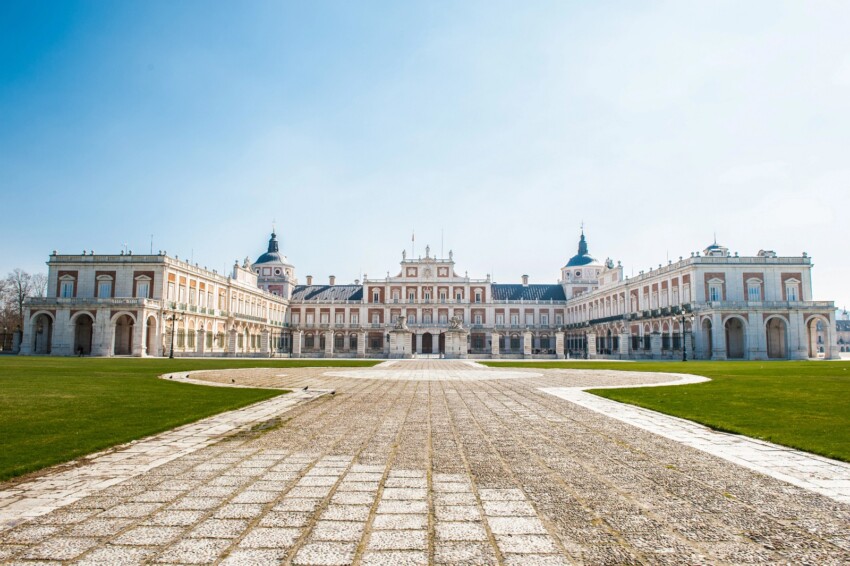
Toledo’s central location in the Castilla-La Mancha region makes it an ideal starting point for exploring other places of interest. Hiring a car is recommended to comfortably reach the various destinations.
Only 60 km from Toledo, Consuegra offers one of Spain’s most iconic landscapes: a series of white windmills lined up on a hill, immortalised by Cervantes in Don Quixote. The medieval castle that dominates the town and the restored mills, some of which can be visited, create a unique setting.
The Royal Palace of Aranjuez and its gardens, a UNESCO World Heritage Site, represent one of the best examples of Spanish royal architecture. Just 45 minutes from Toledo, this monumental complex offers a perfect example of how the kings of Spain lived in their holiday palaces.
The villages and landscapes that inspired Cervantes are easily accessible from Toledo. Places like Campo de Criptana, with its windmills, and El Toboso, the village of Dulcinea, allow you to immerse yourself in the world of Don Quixote.
Due to its proximity to Madrid, many people reach Toledo on a day trip directly from the Spanish capital. However, if you intend to have a touring holiday, spend the evening or dedicate several days to it, it might be convenient to reserve a hotel in Toledo. The historic centre of Toledo offers the most authentic experience for your stay. Boutique hotels in old palaces allow you to experience the medieval atmosphere of the city. The area around the Cathedral is particularly charming, but the streets can be noisy during the day due to the flow of tourists.
The Jewish quarter is one of the most charming areas to stay. Here you will find small charming hotels and historic houses converted into hotels. The area is quieter and retains a particularly atmospheric atmosphere in the evening hours, when the daily tourists leave the city. The Zocodover area, close to the Plaza Mayor, is ideal for those seeking the convenience of being in the heart of city life. This area offers easy access to the main monuments and the best offer of restaurants and shops.
Toledo is about 80 km from Madrid and can be reached in less than an hour with a rental car via the A-42 motorway.
If you prefer travelling by public transport, there is a direct train that leaves approximately every hour from Atocha station; the journey takes 33 minutes. The last train back to Madrid is around 9.30 p.m., so you have enough time to visit all the main attractions of the city.
Another option is to book a guided tour from Madrid, either a day or half-day tour.
What's the weather at Toledo? Below are the temperatures and the weather forecast at Toledo for the next few days.
The magnificent Toledo is located in the Castile-La Mancha region, exactly one hour's drive south from the centre of Madrid.